WoodTalks Speaks to the Benefits of Wood and Mass Timber

This week, 800 buyers, sellers and specifiers of value-added wood products have gathered in Whistler for the Global Buyers Mission (GBM), Canada’s largest show of its kind. And on day one, WoodTALKS—a wood design and construction education event held in conjunction with the GBM—was front and centre. Ken Hori, BC Wood’s Program Manager opened the event, welcoming a record 130 architects and other building sector professions.
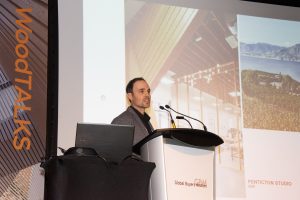 First to the podium was Robert Cesnik of HDR Architecture Associates, speaking on the Evolution of Mass Timber Design in BC’s Okanagan. Starting with glulam applications back in 2003, Cesnik wove a story of product experimentation and advancement in design and engineering that culminated in many iconic mass timber structures—notably the Penticton Lakeside Resort. Key decision drivers for his firm’s use of cross laminated timber include its carbon benefit, quick construction time and physical attributes (e.g., ability to cantilever in two directions). To ensure project success, Cesnik emphasized the importance of good relationships between the design, engineering and construction professions but added that ensuring the client is comfortable with these cutting-edge products is also key. Looking to the future, Cesnic spoke of four current mass timber designs in the Okanagan, including a proposed 19-storey residential tower!
First to the podium was Robert Cesnik of HDR Architecture Associates, speaking on the Evolution of Mass Timber Design in BC’s Okanagan. Starting with glulam applications back in 2003, Cesnik wove a story of product experimentation and advancement in design and engineering that culminated in many iconic mass timber structures—notably the Penticton Lakeside Resort. Key decision drivers for his firm’s use of cross laminated timber include its carbon benefit, quick construction time and physical attributes (e.g., ability to cantilever in two directions). To ensure project success, Cesnik emphasized the importance of good relationships between the design, engineering and construction professions but added that ensuring the client is comfortable with these cutting-edge products is also key. Looking to the future, Cesnic spoke of four current mass timber designs in the Okanagan, including a proposed 19-storey residential tower!
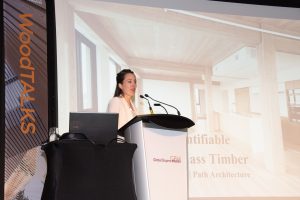 Emily Dawson of Kaiser + Path kicked off her presentation on Quantifying the Appeal of Mass Timber with a warning on the “tyranny of the quantifiable”. Her message put simply: numbers matter but so does incorporating the full range of product reasons and benefits. The key driver for her full-service Portland based firm—which designs, builds and markets/sells her structures—is the need for the construction sector to be part of the solution to climate change. Kaiser + Path’s focus is on structure first, but according to Dawson, “wood comes with significant commercial appeal for tenants”. Recent examples include an IT firm that viewed one of her timber buildings as a “draw for people talent” and a medical business that sees wood providing a “healing environment” for their customers. Not surprisingly, Dawson’s quantitative assessment of mass timber included the benefits of construction predictability and risk reduction potential for lenders.
Emily Dawson of Kaiser + Path kicked off her presentation on Quantifying the Appeal of Mass Timber with a warning on the “tyranny of the quantifiable”. Her message put simply: numbers matter but so does incorporating the full range of product reasons and benefits. The key driver for her full-service Portland based firm—which designs, builds and markets/sells her structures—is the need for the construction sector to be part of the solution to climate change. Kaiser + Path’s focus is on structure first, but according to Dawson, “wood comes with significant commercial appeal for tenants”. Recent examples include an IT firm that viewed one of her timber buildings as a “draw for people talent” and a medical business that sees wood providing a “healing environment” for their customers. Not surprisingly, Dawson’s quantitative assessment of mass timber included the benefits of construction predictability and risk reduction potential for lenders.
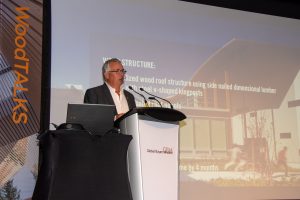 Renowned architect Peter Busby spoke of his love of wood and its positive contribution to society’s social and environmental needs. Posing and then answering his own question on ‘why wood’, Busby spoke of GHGs and climate change, the challenge of housing seven billion people and how wood innovation has been rising to the challenge faster than alternative products. Looking to wood’s future, Busby sees more prefabrication and concealed fasteners, and taller buildings due to innovation in shrinkage and fire safety solutions (e.g., charring). Consistent with his firm’s reputation as a catalyst in the growth of green architecture, Busby spoke of their design proposal for a 40-storey wood tower in Vancouver, which if built will become the world’s tallest wood residential tower. Designed for the “greenest of the greenies”, it will meet or exceed passive house and net zero carbon goals.
Renowned architect Peter Busby spoke of his love of wood and its positive contribution to society’s social and environmental needs. Posing and then answering his own question on ‘why wood’, Busby spoke of GHGs and climate change, the challenge of housing seven billion people and how wood innovation has been rising to the challenge faster than alternative products. Looking to wood’s future, Busby sees more prefabrication and concealed fasteners, and taller buildings due to innovation in shrinkage and fire safety solutions (e.g., charring). Consistent with his firm’s reputation as a catalyst in the growth of green architecture, Busby spoke of their design proposal for a 40-storey wood tower in Vancouver, which if built will become the world’s tallest wood residential tower. Designed for the “greenest of the greenies”, it will meet or exceed passive house and net zero carbon goals.
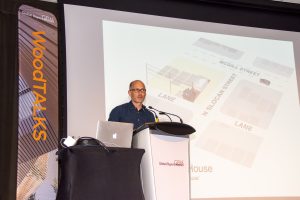 Bryn Davidson, of Lanefab Design/Build spoke of his company’s journey from laneway homes to passive house to green building and finally, net positive developments. Davidson credits the City of Vancouver’s 2009 decision allowing laneway homes as the initiator for his business and his firm’s choice to build to the Passive House standard as their differentiator in the market. In evaluating the significance of their approach on GHGs, Davidson noted the importance of getting beyond green building and net zero to “net positive”. Key is going beyond the structure and including consideration for location (e.g., walkable versus driving), what was there before (e.g., greenfield or a teardown) and how good the existing building is from a GHGs perspective (e.g., how negative the footprint is and if it can be economically renovated to net positive). According to Davidson, societal change requires zoning reform and state/provincial consideration to remove barriers, ensure the community changes are spread out, and provide economy of scale.
Bryn Davidson, of Lanefab Design/Build spoke of his company’s journey from laneway homes to passive house to green building and finally, net positive developments. Davidson credits the City of Vancouver’s 2009 decision allowing laneway homes as the initiator for his business and his firm’s choice to build to the Passive House standard as their differentiator in the market. In evaluating the significance of their approach on GHGs, Davidson noted the importance of getting beyond green building and net zero to “net positive”. Key is going beyond the structure and including consideration for location (e.g., walkable versus driving), what was there before (e.g., greenfield or a teardown) and how good the existing building is from a GHGs perspective (e.g., how negative the footprint is and if it can be economically renovated to net positive). According to Davidson, societal change requires zoning reform and state/provincial consideration to remove barriers, ensure the community changes are spread out, and provide economy of scale.
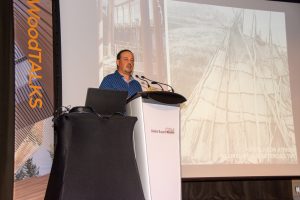 Wrapping up day-one was architect Alfred Waugh, the principal of Formline Architecture in Vancouver, who presented on Indigenuity in Architecture. Waugh’s focus was on the synthesis of cultural sensitivity and environmental responsibility and how best to bring together Western society with First Nations’ knowledge, connection to the land and nature-centred systems. The key drivers for his design approach being cultural identity, environmental footprint, community engagement and local ingenuity. Examples cited include the Squamish Lil’Wat Cultural Centre, which was designed similarly to longhouses; the First People’s House at the University of Victoria interpretation of the slotted post and beam connection for the Coast Salish Long House; and the landscape for Indian Residential School, History and Dialogue Centre at the University of BC, so that it blends with the land and provides areas for outdoor learning.
Wrapping up day-one was architect Alfred Waugh, the principal of Formline Architecture in Vancouver, who presented on Indigenuity in Architecture. Waugh’s focus was on the synthesis of cultural sensitivity and environmental responsibility and how best to bring together Western society with First Nations’ knowledge, connection to the land and nature-centred systems. The key drivers for his design approach being cultural identity, environmental footprint, community engagement and local ingenuity. Examples cited include the Squamish Lil’Wat Cultural Centre, which was designed similarly to longhouses; the First People’s House at the University of Victoria interpretation of the slotted post and beam connection for the Coast Salish Long House; and the landscape for Indian Residential School, History and Dialogue Centre at the University of BC, so that it blends with the land and provides areas for outdoor learning.
Day two for the WoodTalks starts this morning with BC Wood’s networking tradeshow of 82 value-added wood manufacturers, a presentation on BC’s Energy Step Code, Mass Timber Building Closures and Prefabrication by Graham Finch of RDH Building Science, and finally, BC Wood’s mini-seminar series with the tradeshow exhibitors.